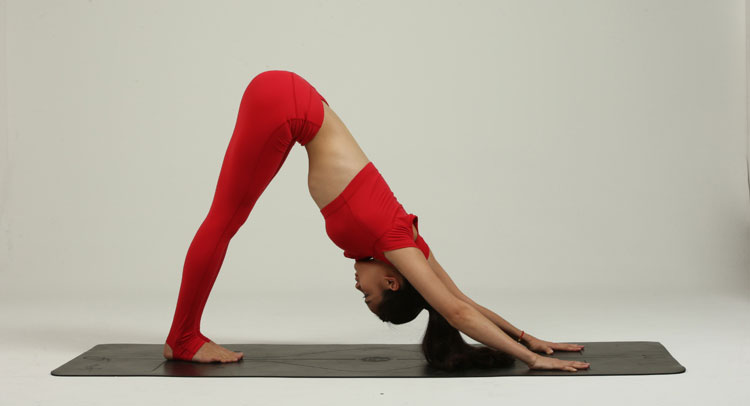
Ashtanga (ash-tang-a) is the system of Yoga taught by Sri K. Pattabhi Jois at the Ashtanga Yoga research institute in Mysore, India. This method of Yoga involves synchronizing the breath with progressive series of postures - a process producing intense internal heat and a profuse, purifying sweat that detoxifies muscles and organs. The result is improved circulation, a light and strong body, and a calm mind.
The Sanskrit word hatha is thought to be derived from the verbal root hath which means "to force" or "hold firmly" and thus Hatha Yoga is sometimes called "forceful yoga." It is also thought to be the combinates of two words ha meaning "sun" and tha meaning "moon" and thus Hatha Yoga is said to balance the opposing energies of the body - sun and moon, male and female, etc. Hatha Yoga is most often identified with the practice of physical postures (asana) and breathing techniques (pranayama).
Bikram's Beginning Yoga Class is a twenty-six asana series designed to scientifically warm and stretch muscles, ligaments and tendons, in the order in which they should be stretched. Bikram Yoga's twenty-six posture exercises systematically move fresh, oxygenated blood to one hundred percent of your body, to each organ and fiber, restoring all systems to healthy working order, just as Nature intended. Proper weight, muscle tone, vibrant good health, and a sense of well-being will automatically follow.
Power Yoga combines the ancient "eight limbs" of Yogic wisdom revfealing a systematic set of proven age-old principles, physical practices, attitudes, and perspectives. Power Yoga uncovers the root causes of stress and provides the means to conquer it, demonstrates the value of exercise and attitude, and harnesses the power of discipline and inner balance. It is a muscle-shaping, mind-sculpting workout that crosses all borders and appeals to any person who has the desire for true and permanent changes in his or her body and life. The most well-know proponent and teacher of Power Yoga is Baron Baptiste.
Sivananda is one of the world's largest schools of Yoga. It is very supportive to beginners. Developed by Swami Vishnu-Devananda and named for his teacher, Swami Sivananda, Sivananda Yoga follows a set structure that includes breathing, classic asanas, relaxation, as well as principles of diet and positive thinking. The Complete Illustrated Book of Yoga, written by Swami Vishnu-Devananda and first published in 1960, was one of the first, and continues to be one of the best, introductions to Yoga available.
Anusara (a-nu-sar-a), means "flowing with Grace," "going with the flow," "following your heart." Founded by John Friend in 1997, Anusara Yoga is a hatha yoga system that unifies Universal Principles of Alignment with a non-dual Tantric philosophy that is epitomized by a "celebration of the heart." In this philosophy we take the premise that everything is supreme Consciousness - nothing exists that is not supreme Consciousness. It encompasses a vision of totality in which each person is seen as equally divine in every part - body, mind, and spirit. The body and mind are honored as sacred vessels through which the divine radiance of supreme Consciousness can shine. Each of us is regarded as essentially good, so there is a lot of acceptance and allowance in this system for difference and deviation.
Sri Swami Satchidananda described Integral Yoga as: "...a flexible combination of specific methods to develop every aspect of the individual: physical, intellectual, and spiritual. It is a scientific system which integrates the various branches of Yoga in order to bring about a complete and harmonious development of the individual."
The word ISHTA has a two-fold definition. In Sanskrit, it means developing a personal yoga practice that meets your individual needs. ISHTA also stands for the Integrated Science of Hatha (the physical practice of yoga that creates balance), Tantra (the yogic philosophy that recognizes the perfection in all beings), and Ayurveda (the Indian science of healing). Developed by Alan Finger and his father Kavi Yogiraj Mani Finger, it is a tradition with roots in teachings by Paramahansa Yogananda, author of the spiritual classic, Autobiography of a Yogi.
Iyengar yoga emphasizes posture and the development of balance and alignment. To support students' explorations of postures, Iyengar yoga makes use of a wide variety of props: belts, blocks, pillows, and balls. Iyengar is one of the most widely practiced yoga techniques in the West. It was developed in India by B.K.S. Iyengar and responds to individuals with varying limitations and capacities for accomplishing postures. Iyengar yoga is noted for great attention to detail and the precise alignment of postures.
Swami Kripalvananda
Kripalu Yoga puts a great emphasis on the mechanics of Yoga - proper breath and alignment - as well as in the inner, spiritual dimensions of Yogic practice. Students are encouraged to honor "the wisdom of the body" and to work according to the limits of their individual flexibility and strength. There are three stages in Kripalu Yoga. Stage one focuses on learning the postures and exploring your body's abilities. Stage two involves holding the postures for an extended time, developing concentration and inner awareness. Stage three is called "Meditation in Motion," in which movement from one posture to another arises unconsciously and spontaneously. Kripalu Yoga was developed by Yogi Amrit Desai, who was inspired by his teacher, Swami Kripalvanandaji, a Kundalini Yoga master from India.
Yogi Bhajan
Kundalini Yoga in the tradition of Yogi Bhajan, who brought the style of Yoga to the West in 1969, focuses on the controlled release of kundalini energy, thought to reside at the base of the spine. This style of Yoga pays particular attention to breathwork, which aims to get energy moving quickly, but it also involves classic poses, coordination of breath and movement, and meditation.